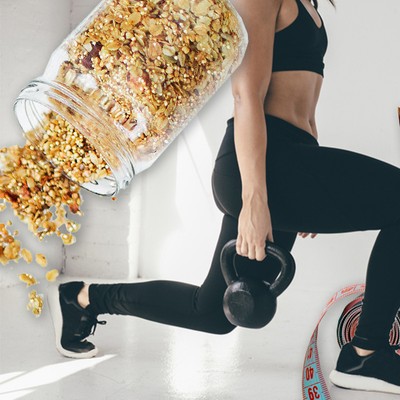
The Truth About Exercise & Appetite
WORKOUT: HIIT session
HUNGER LEVEL: Not hungry
THE SCIENCE: After an hour in the gym, it seems logical your tummy would be rumbling and you’d be ready to refuel. But the truth may be far from it, according to Equinox personal trainer Miki Ferris: “HIIT-style workouts have been shown to suppress the appetite due to reduced levels of ghrelin, the hunger hormone. Research on male athletes showed that when they worked to a heart rate of 75% of their maximum capacity, they felt significantly less hungry after their session. Studies also show there’s little variation between the sexes, so this could explain why a sweaty, intense workout leaves you feeling far from hungry.” Ferris believes this could be due to evolutionary survival mechanisms – when experiencing the need to run away or after something, the last thing our ancestors needed to feel was hungry.
WORKOUT: 90-Minute Yoga Class
HUNGER LEVEL: Ravenous
THE SCIENCE: Research suggests lower-intensity workouts sustained over a longer period of time, for example a long walk or yoga class, can leave you feeling hungrier than an intense run. Ferris says this comes down to the fact the body perceives slower-paced, endurance workouts as a famine. “When travelling for long distances or foraging for food, our ancestors would have been motivated by the need to find food and their hunger levels would rise,” she explains. By all means refuel with a balanced meal or snack post endurance session, but be wary of over-compensating for the calories you think you may have burned. “Post-exercise nutrition should always be tailored to the activity, including intensity. After endurance activities, aim for a higher carb to protein ratio,” says Ferris.
WORKOUT: Strength Training
HUNGER LEVEL: Hungry
THE SCIENCE: As James Yuill, trainer at Bodydoctor Belgravia explains, lifting weights can make you feel hungrier due to the higher energy expenditure and increased stress on the central nervous and adrenal systems. Strength training causes small tears in muscle tissue and, as those tissues heal, you build stronger muscle. Ferris agrees: “As a general rule, appetite increases with muscle mass. When we strength train, we burn calories and utilise glycogen stores. After training, your body needs fuel for the repair process and to replenish depleted glycogen levels. Aim for a higher protein-to-carb ratio after these types of sessions.”
WORKOUT: Swimming
HUNGER LEVEL: Very hungry
THE SCIENCE: Swimming isn’t just a workout for your lungs, heart and muscles; it also makes your body do the extra work of maintaining a healthy body temperature while you’re immersed in water that’s usually at least 15-20 degrees cooler. Research suggests your body activates its brown fat stores when the temperature plummets, boosting your metabolic rate in order to keep warm. One study found those who exercised in colder water consumed 44% more calories following their workout than those who expended the same amount of energy in warmer water. As Yuill explains, “All humans have an innate ability to raise body temperature by digesting food. So, typically, an individual with a lower body temperature will eat more to warm up.”
WORKOUT: Rest Day
HUNGER LEVEL: Hungry with cravings
THE SCIENCE: As Ferris explains, research suggests we can feel hungrier the day after an intense workout as our appetite hormones send signals to the brain to tell us to eat more. “With rest comes repair and the healing process requires energy. The body may also be making up for an energy deficit,” she says. This could be down to the afterburn effect (aka ‘EPOC’, or excess post-exercise oxygen consumption) as the body continues to burn calories at an increased rate after exercise for up to 24 hours, depending on the individual. Cravings on a rest day are common too, as the body craves certain macronutrients (vitamins and minerals) that may have been depleted during an intense session.
DISCLAIMER: We endeavour to always credit the correct original source of every image we use. If you think a credit may be incorrect, please contact us at info@sheerluxe.com.